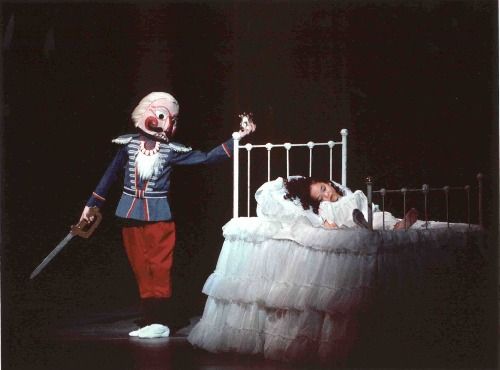New York City Ballet: The Nutcracker / New York State Theater, Lincoln Center, NYC / November 28, 2003 – January 4, 2004
 The Nutcracker
The Nutcracker
In this latter guise—conveyer of child to endless rehearsals—I, along with the other moms, dads, and nannies, occasionally got to watch a stage run-through. I remember in particular a dress rehearsal supervised by Mr. B himself. Decades later, it still provides me with a clue to the great man’s sensibility. On this occasion, matters had worked around to the point where Marie, the ballet’s juvenile heroine, terrified by the attack of the predatory mice, flees to a white-ruffled bed, stands on it for a moment, all innocence and vulnerability in her little white nightdress, then tumbles backward in a faint.
Her fall looked fine, albeit a little smudged, to me, but Balanchine wasn’t satisfied. He asked that she repeat it and was no happier with the result. He went up to her and, with typical gentle courtesy, worked directly with her—quietly and intimately, as if the two of them were alone on the stage—explaining and showing what he wanted. Then he stood back as she tried again. It was still not right in Balanchine’s eyes. Turning from her so that she didn’t see his little twitch of impatience and exasperation, he addressed the children’s ballet master and the other assistants in attendance: “Somebody teach her how to faint.”
How to bow, how to faint, how to waltz. Over years of mere glimpses of Balanchine at work and many an interview with his dancers, I came to understand that these skills were as important to the choreographer as a breathtaking mastery of the classical dance vocabulary he did so much to advance. I think it disturbed him at the core when dancers (even child dancers, because they represented his art’s future) couldn’t execute convincingly the moves that any citizen of civilization can perform almost instinctively. Balanchine, as his work reveals, gloried in the high artifice of ballet, but he never divorced his art from human nature.
Photo credit: Paul Kolnik: George Balanchine’s Nutcracker
© 2003 Tobi Tobias



